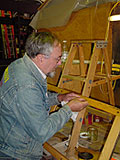Story
Back on Track: Car No. 59's Extreme Makeover
When asked to describe the Colorado Springs & Suburban Railway Car No. 59, Greg Roberts said, “She’s unique, the last of her kind.”
The Pikes Peak Historical Street Railway Foundation board member may be forgiven for referring to the historic trolley car as a lady. After all, Car No. 59 has undeniably gorgeous attributes. When she emerged from the Laclede Car Company’s St. Louis plant in 1901, the double-truck debutante boasted impressive measurements: forty-eight feet long, eleven feet tall, and eight feet wide. And like all southern belles, she knew how to accessorize. Her etched-glass transoms, quarter-sawn oak paneling, polished bronze hardware, bird’s-eye maple veneer, and mother of pearl call buttons placed her in a class by herself.
In her prime, Car No. 59 shuttled commuters and tourists around Colorado Springs with grace and poise. She was part of a fleet of trolleys owned by Cripple Creek Mining District millionaire Winfield Scott Stratton. As a former carpenter, Stratton understood the value of fine craftsmanship. In 1901, he purchased the ailing and inadequate Colorado Springs Rapid Transit Railway Company and turned it into a profitable enterprise. Stratton extended the tracks, ordered new cars, and built a new car barn and powerhouse. No. 59 was one of ten state-of-the-art electric vehicles that drove up the company’s profits in the early 1900s.
Stratton died just one year after taking over the line, but his spare-no-expense management style lived on. The company offered daily commuter service to the city’s suburbanites and fostered the tourism industry by building tracks into Manitou Springs and Colorado City. Car No. 59 enjoyed this golden age of mass transit until about 1911, when a cheap, noisy little contraption called the Model T drove her company’s bottom line into the red.
The automobile revolution ruined the Colorado Springs & Suburban Railway. The company tried to compete by using less expensive Birney cars in the 1920s, but to no avail. The line went belly up in 1930 and sold off its rolling stock to area residents for use as summer cottages, chicken coops, and storage sheds. Car No. 59 retired to a stationary life as a garage addition.
In 1982, train buffs founded the Pikes Peak Historical Street Railway Foundation to foster appreciation for Colorado Springs’s old electric rail transit system. Eight years later, Car No. 59 was donated to the Foundation. At first, the Foundation had a modest goal: to restore No. 59 and operate her in a park or museum setting. But as the group acquired more vintage cars, it’s mission changed.
In the spirit of Winfield Scott Stratton, the Foundation invested its energy into a grand design. In addition to restoring the cars, the group plans to restore and operate a street railway connecting the three historic districts of downtown Colorado Springs, Old Colorado City, and Manitou Springs. If all goes according to plan, the system will not only be a working educational tool and tourist attraction, it will offer convenient commuter service for area residents.
Realizing this audacious plan will take time and money. The State Historical Fund, long committed to integrating history into our everyday lives, has supported the project with three grants totaling $112,000.
The most recent grant will partially fund Car No. 59’s extreme makeover. Like mechanically minded plastic surgeons, preservationists will transform the 103-year-old-old car from “frumpy” to “fabulous” by restoring one of her two trucks (wheel assemblies), replacing cast-iron seats, restoring corner seats, and replacing passenger compartment windows. More work will be needed in the coming years, but this old gal’s best days are ahead of her.

